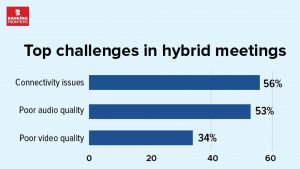A recent study among white collar workers in the light of work-from-home strategy has shown that hybrid meetings are more often counter-productive:
A study by Swiss-American manufacturer of computer peripherals and software, Logitech International, has found that hybrid meetings may be creating uneven playing fields for meeting participants. The company interacted with some 1000 white-collar workers in Singapore, examining the state of current working arrangements, impact of hybrid work on meetings and the challenges that business leaders and employees face in this new way of working.
A key finding of the survey was that 54% of respondents felt that they had fewer opportunities to build rapport among meeting participants while 39% agreed that their input would be valued more if they were attending the meeting physically instead of virtually, and 38% felt less included as compared to in-person meeting participants.
GIVING EQUAL CHANCE
It also revealed that while 60% of respondents agree that hybrid meetings would be more productive if all participants had an equal chance to speak and contribute, 65% of those who participate in hybrid meetings in-person shared that they tend to engage more with participants that are in the same room.
Another key finding is that access to technology a key driver for successful hybrid meetings. More than half of the survey participants felt that technical issues are the most significant challenges with hybrid meetings, with connectivity issues (56%) and poor audio quality (53%) ranking amongst the top concerns. And 34% of respondents also shared that poor video quality was an issue they experienced during hybrid meetings. Interpersonal issues such as getting talked over by other participants during meetings (29%) and difficulty contributing to discussions (26%) were also cited as challenges in hybrid meetings.
The report said despite organizations welcoming employees back into physical office spaces, more than 6 of 10 respondents (63%) continue to work remotely to some extent, either in a hybrid or fully remote work arrangement.
GETTING IT RIGHT
Logitech’s Head of Video Collaboration, Southeast Asia, Bryan Lee said hybrid work will continue to be the norm as both employers and employees alike see the benefits of flexible working arrangements. “The increased frequency of hybrid meetings will come with a host of new challenges for organizations, creating a strong impetus for business leaders to get hybrid meetings right,” he added.
The study pointed out that organizations have adapted to new ways of collaborating to accommodate the varying working arrangements of their workers. Hybrid meetings, which have a mix of virtual and in-office participants in different locations, are becoming more common.
Bryan explained that the opportunity to participate is the most important factor in establishing a sense of equity in hybrid meetings. Facilitating equitable meetings – ensuring that all meeting participants have equal opportunities to contribute to discussions no matter where they are – needs to be a key consideration for business leaders, said, adding: “By bridging the gaps between in-person and virtual meeting participants, businesses will be able to foster a productive, collaborative, and connected work environment.”
ROLE OF CRITICAL TECHNOLOGY
The study also says in order to address these pain points, organizations will have to ensure that employees have access to critical technology, including string network connectivity and video conferencing devices. In fact, the critical role of video conferencing technology in solving the meeting equity problem. Over 6 of the 10 respondents (61%) agreed that hybrid meetings are more engaging when video conferencing systems with high-quality audio and video output are used, it said.
CLOSING THE GAP
Logitech maintains that in today’s increasingly hybrid work environment, there are several key aspects companies must consider in order to enable seamless collaboration, foster engagement, and place virtual meeting participants on equal footing with their counterparts in the conference room. These are:
Equip: Provide teams with enterprise-level equipment such as in-room video conferencing systems, webcams, microphones, and earbuds, which enables organizations to build a consistent, reliable experience that is natively integrated with its ecosystem of choice.
Simplify: With employees constantly switching between in-office and home work environments, creating an easy employee experience by ensuring that the home office closely resembles their office set-up will emerge as a top priority for organizations.
Empower: Fostering meeting equity requires facilitators and organizers to take an active approach to empower and encourage engagement from virtual participants. They have to practice active facilitation, minimize visual and audio clutter, and minimize side conversations.
____________________________
Read more-







